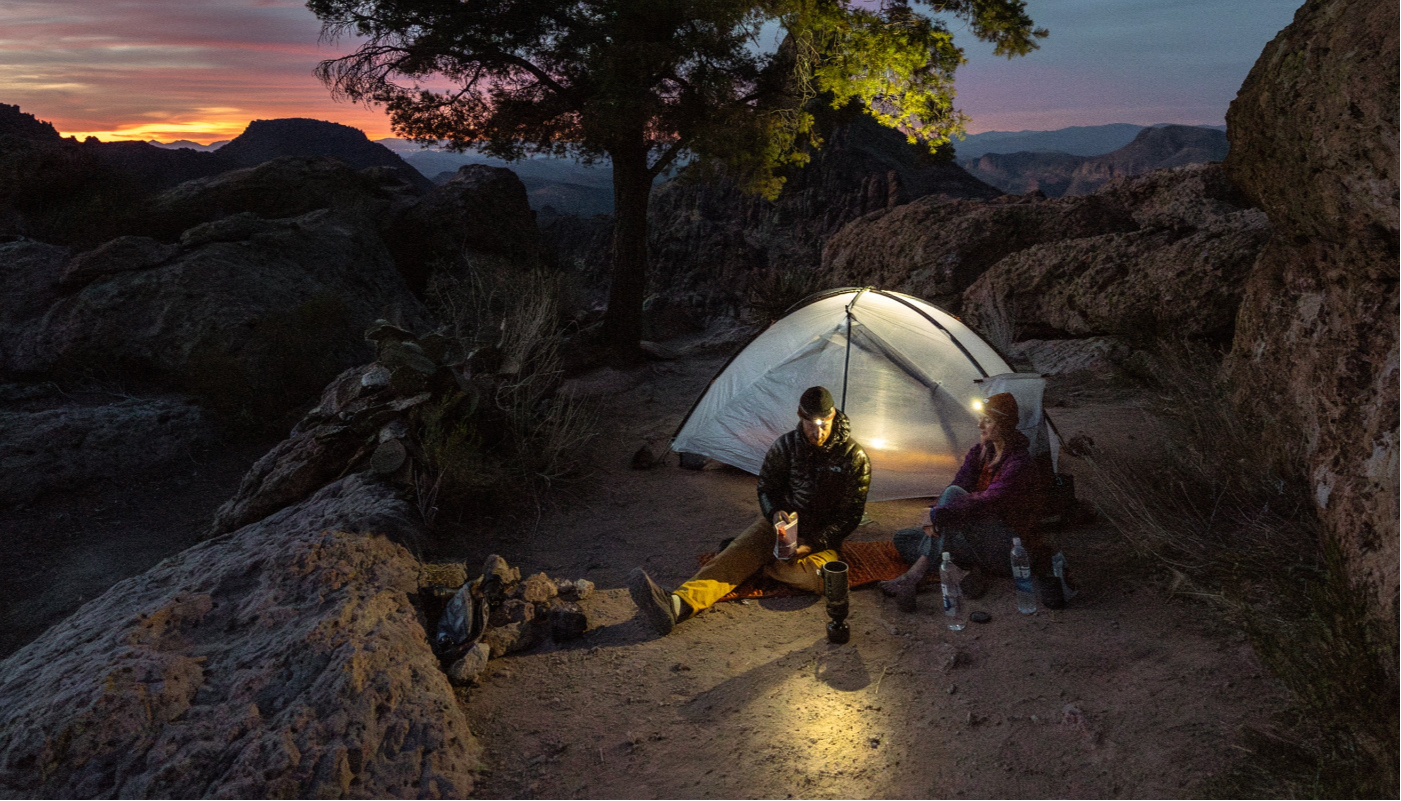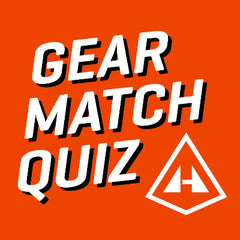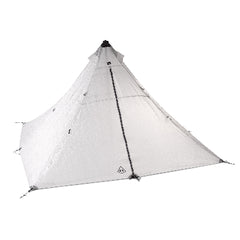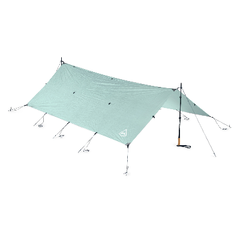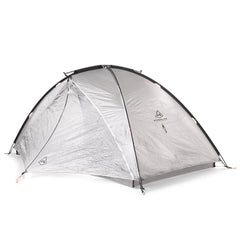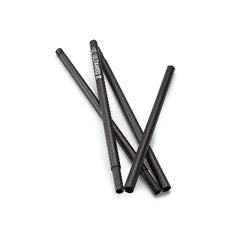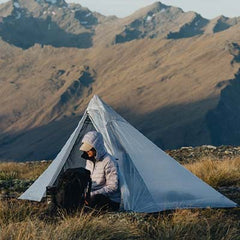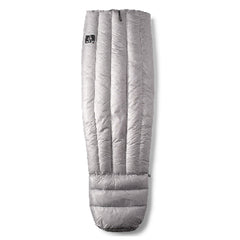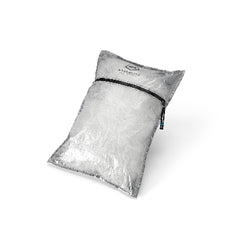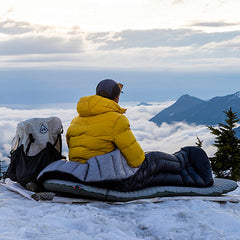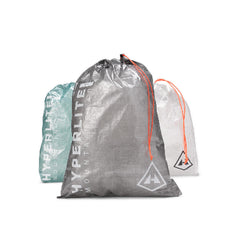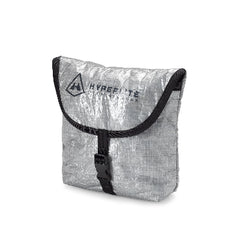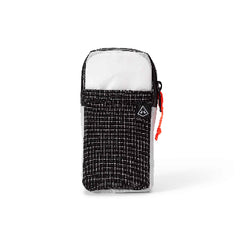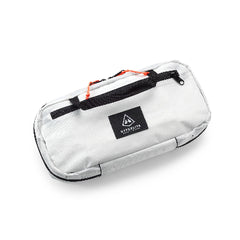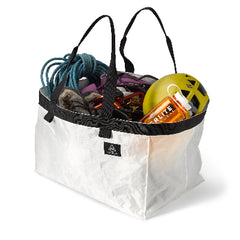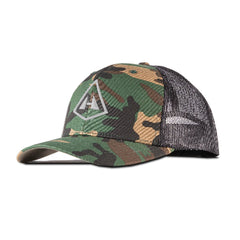Words and Photos by Carl Stanfield - IG - @prof_carl
Bust out your waterproof notebooks, Trailheaders! Today's topic is a shakedown, and the Professor is in! Carl "Professor" Stanfield has dumped out the contents of his pack to show you what he's carrying these days and why. With an odometer that just won't stop rolling over, with clicks along the Appalachian Trail, Pacific Crest Trail, a calendar year triple crown, and countless other backcountry miles, you can bet you're in for an education!

BACKPACK
HMG Unbound 40
The AZT was my first outing with an HMG pack! I went with the Unbound 40 because it was a bit on the smaller end of the scale while still having enough room for me to carry the Unbound 2P tent for my partner and me (she brought her four-pound camera, so I balanced us out by carrying the shelter). Honestly, the feature that sold me most on the Unbound 40 was the bottom pocket. I've gotten used to having accessibility there using smaller packs over the years, and I just gotta have it now.
I tried several hundred miles on the AZT going hip beltless, but I found the loads I was leaving towns with were just a bit too heavy for comfort. The modular system made it easy to slap my hip belt back on, which I'd left at home, and get right back to moving with ease. I was also a big fan of the double pocket system on the front panel, making it easy to divy up my "outside the pack" gear. I'd keep my water filter and bladder in the little pocket and everything else in the normal larger pocket.

SLEEPING BAGS + QUILTS
Enlightened Equipment Custom Revelation 20 & Sea to Summit Thermal Liner
I've been using Enlightened Equipment quilts for thousands of miles, and as usual, my experience on the AZT didn't disappoint. I found the 20-degree rating to be perfect for me across the board. Between March 10 and May 10, there were plenty of cold nights at the varying altitudes the trail traverses. I only experienced a few below freezing, and my 20-degree quilt performed great.
The Revelation is the model that allows the footbox to fully unzip, so on warmer nights, just the blanket did the trick. I'm also a big fan of pairing with a sleeping bag liner.
Ever since my first thru hike in 2018, I've been an advocate of sleeping bag liners. Even more than the extra warmth, I find them to be extremely useful for prolonging the lives of my quilts by keeping them clean. I'd even make a case for putting my liner in my hygiene category. At the end of sweaty desert days, I'm absolutely filthy, particularly my legs. Instead of trying to use precious water or fancy wipes to clean myself off before bed, I simply slide my whole body into my liner. In towns, they work as great laundry bags and can even be washed themselves. With the frequency of town stops I took on the AZT, I was able to do pretty regular laundry, and my sleep system stayed clean and cozy.
STUFF SACKS + PODS
Trash Bag and Various Ditty Bags
Ever since I really paired down my kit, I've found that I'm able to keep my things well organized with just a few little ditty bags. When I pack my backpack, I always line it first with a trash bag. Then the first thing I add is my quilt, followed by my clothes and rolled up deflated sleeping pad. I then have 3-4 other little bags to pack into the dead space: a toiletry bag (an old down jacket stuff sack), a first aid kit (a small DCF zipper bag), a journal (also in a small DCF zipper bag), and my electronics (stored in the Small Drawstring Stuff Sack that came with my HMG Ground Cloth). All of that gets rolled and sealed into the trash bag every day, then my foodbag and tent are stored on top before closing up my bag.

ULTRALIGHT TENTS + SHELTERS
Unbound 2P w/ HMG Ground Cloth
As with my backpack, this was also my first trip testing out an HMG tent! It also happened to be the longest backpacking trip I've ever been on sharing any gear. My partner, Treats, joined me for the first 400 miles of the trail, which meant we shared the tent for half the trail.
She's 5'4" and I'm right at 6'. We found the tent to be the perfect size for us. We could cuddle up when we wanted to, and also roll over and have our own space at times. We found we each preferred opposite door opening directions, which made it easy for us to pick which side we wanted each night. We had several wet nights of rain, and after Treats left, I had several nights of snow and the worst thunderstorm I've ever camped in. Even with subpar setup that night, the tent still held up strong against the winds.
Just as often as we set up the tent, we elected to cowboy camp on the HMG Ground Cloth, which was the exact perfect dimensions for two, even with my jumbo sleeping pad. It was tough and reliable, and across the entire jagged desert floor, we never got a single hole in it.
SLEEPING PADS + PILLOWS
NEMO Tensor Long/Wide Insulated & Sea to Summit Pillow
I would love to be a person who gets great sleep on a simple and easy foam pad. I fully believe that a foam sleeping pad is objectively superior to even the best inflatable pad in every single way–except comfort. And I find that my sleeping comfort really, really matters.
I attribute my superbly cozy nights on the AZT to my insulated sleeping pad. I don't always go for the Long/Wide, but man, that thing really feels like a bed. I slept wonderfully on trail. I'd even say I had some of the best nights of sleep outdoors I can remember.
When it comes to sleep, I find that I'm a bit of a boujee sleeper. I like to have two pillows: one for my head and one for between my legs. For my head pillow, I like to use an inflatable. Even when they start to leak on me (as this one has), I find I wake up often enough in the night that I don't mind the puff of breath every several hours to keep it going. As for my leg pillow, I either use the packed-up tent if cowboy camping or otherwise fill the empty tent stuff sack with my extra clothes.

STOVES
Gas One
In all my time backpacking, I've never not wanted a hot meal at the end of the day. I am absolutely a cooker on trail, 100% of the time. I cook dinner every night. I've found the simplest and lightest stove to be the Gas One, a cheap sub-1-ounce canister stove from Amazon. From what I can tell, it is exactly the same as the BRS 3000T, with the only difference being that this one is painted to look like a pocket rocket. I have now put over 9,000 miles on this same little $20 stove, and it's still going strong.

KITCHEN COOKWARE
Evolved Supply Co 750 Pot and Titanium Spoon
I find that a 750mL pot is the perfect size for all my on-trail ramen escapades. I've also enjoyed carrying a 900mL at times, but in trying to save a few ounces, I like what I can do with a 750mL. The majority of my dinners on trail are ramen bombs, but a 750mL is just big enough for a box of macaroni or Velveeta shells, too. The new model from Evolved Supply Co has a couple of handy features I didn't even know I was missing that I ended up being a huge fan of. In addition to the traditional foldable mug handle, it also has a bail handle to hold it from the top, which I found to be extremely efficient and safe when removing a hot pot from my stove. The lid also has a tiny wooden knob to grab it with, which was also really handy at keeping my handys burn-free.

HYDRATION VESSELS
Smart Water 1.5L Bottle, Cnoc 3L Bladder, Various "Fun Drink" Bottles
My go-to drinking vessel while backpacking is always a Smart Water bottle. Their sports cap is just so wonderfully multifunctional. It's efficient and easy to drink out of, and it also doubles as the perfect backflushing adapter for my Sawyer Squeeze.
For collecting water, I love Cnoc. I've used the 2L quite a bit before, but I figured I'd up my capacity for the desert to 3L. Even when it's full and heavy, I've never had issues hauling them around nor have I found any leaks. Plus, the extra capacity means extra gravity power when I'm hanging it up for a gravity filter.
Finally, I also keep a bonus rotating bottle on me at all times: Powerade, Gatorade, Gatorlyte, whatever the most recent town had. I'll pop one in the fridge (or freezer!) before hitting the trail and have a nice cold drink the first few miles. I do all my mixed drinks in that bottle, and only ever drink plain water from my Smart Water Bottle to prolong its life.

WATER TREATMENT
I'm pretty loyal to "Old Reliable," the Sawyer Squeeze. I've never gotten sick while using one, even through nasty cow ponds and "whoops, maybe I should've slept with my filter last night" nights. Recently, I've started carrying a tiny carabiner with my water bladder so that when I'm stopping to filter, I can hang my system up and let gravity do the work.

APPAREL
Jolly Gear Triple Crown Button Down | Generic Synthetic Shorts | Long Synthetic Boxer Briefs | Darn Tough Socks (x2) | Enlightened Equipment Torrid Custom Jacket | EE Visp Rain Jacket | EE Copperfield Windpants | Hoka AND New Balance Shoes | Dirty Girl Gaiters
My daily hiking outfit is pretty standard. I've been a fan of Jolly Gear since the beginning. I really think it's the perfect sun hoody. Then I've also jumped on the Windpants train. I've found they're often extremely handy for either a little extra warmth or just having something else to wear around town while doing laundry. And for less than two ounces, it's hard to leave them out of my pack.
For shoes, I went with a new model of Hoka I found last fall, the Skyline Float X. I've had trouble with the Speed Goats being too narrow (even in the wide), but the standard Skylines fit my wide feet great. I already had a few hundred miles on them when I started, but I still managed to get them to the halfway point. There, I picked up the only size 13s on the clearance rack at the running store in Tonto Basin, some New Balance road runners. The tread on them was pretty meh, but they were super comfortable, and I knew the northern half of the trail was relatively flat. They held up great, even in the least flat part of the whole trail, hiking in and out of the Grand Canyon.
HEADLAMPS
To be honest, I'm not totally sure what model of headlamp this is. A buddy of mine gave it to me when I stayed at his house in the middle of a thru hike in 2022. I believe it's the most standard/popular model from Nitecore though. It's fully rechargable, still has a solid battery life after hundreds of hours of use, and is plenty bright to get the job done. It also has two settings of red light, which make it easy to navigate in the dark around other hikers, too.

MULTI TOOLS
Gerber Dime
I typically go with the classic Swiss Army Knife, but since I keep it in my fanny pack and have a hard time believing it makes much difference, I've been going with the Gerber Dime lately. It's several ounces heavier than it needs to be, but it has pliers AND a bottle opener on it, so I find myself impressing other hikers often when I've already got this handy tool in arm's reach at all times.
HYGIENE
Baby Powder w/ Aloe
Toothbrush, toothpaste, and retainer
Bag Balm
One of my trustiest tools on the trail is a good little bottle of baby powder. While I haven't found it to be particularly preventative, I'm often amazed at how quickly it can heal up some bad chafing or a strange rash. Ever since it proved itself to me on my first thru hike, I've never been backpacking without it.
Toothbrush and paste are pretty standard, but I also always carry my retainer on my thru-hikes. Even nearly 20 years after braces, I find that I can't go more than a few nights away from it without noticing my teeth have moved. I try to just wear it in towns, though, so I can properly clean and dry it every time I use it.
Bag Balm is a magical little ointment I heard about a few years ago that is incredible at foot preservation. This one is a preventative measure. I don't use it every day, but if I find my feet are getting worn/rubbed more than normal, I'll lather up my feet with this at the start of the next day before putting on my socks.

TREKKING POLES
Diorite Gear Trekking Poles
Did you know Cnoc also makes trekking poles? They do under the name Diorite Gear. I'd used these poles a few times before the AZT, and even with a hundred or so miles on them prior to leaving, they held up great. The main feature that separates them from the rest of the pack is that their max length is a good bit longer than average. I didn't find I needed the extra length, but the extra bit of pole inside the poles, while connected, made for extra durability, so I could put all 220 pounds of my body on them and have them hold up great, time and time again.

